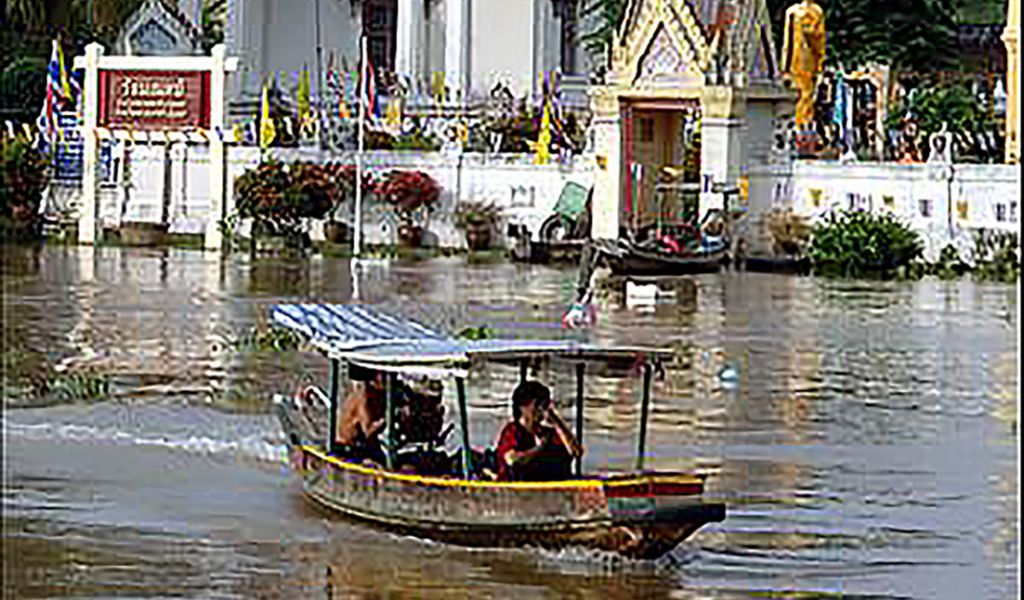Thailand’s floods: Community forestry can respond to an uncertain climate future

Bangkok, Thailand, 26 October 2011: For more than a month, the Northern and Central plains of Thailand have been devastated by the worst floods in half a century. Parts of Bangkok are now underwater as the government declares a national disaster, and residents are preparing for the worst. All around Southeast Asia countries have been experiencing unusually strong storms and heavy rainfall with damaging consequences for both people and the economy, with the Thai government predicting a loss of at least 1% in GDP due to flooding this year. One thing is for sure: a changing climate will bring unpredictable challenges, and RECOFTC is working with communities to better understand and prepare for an uncertain climate future.
Floods and Climate Change
Press and officials have been quick to attribute flooding to climate change – though there is not yet scientific evidence to indicate this is the case. This CNN article presents a well-reasoned account of the recent weather patterns, and for those wondering why events such as this are difficult to attribute to climate change, this article in The Guardian by the climate scientist Myles Allen helps explain the challenges involved. However, greater efforts are being made to determine the attribution of events such as flooding to climate change, including a series of coordinated studies that may take us closer to a clearer understanding of these connections.
This is not to say that the flooding in Thailand isn’t linked to climate change – rather we just don’t know, and are unlikely to know for a good while yet. It is also not certain whether climate change will lead to an increase or decrease in these types of events in the future. The world’s climate system is devilishly complex. It is very difficult (some would say impossible) to stare into the crystal ball and predict accurately what will happen to storm and rainfall events in individual countries, and in some cases, entire regions. In Thailand, the impact of flooding is increasing because people are settling in flood plains and wetlands and therefore natural ‘sinks’ for floods are disrupted.
The way the climate is changing is uncertain. It is this uncertainty that we must adapt to. RECOFTC – The Center for People and Forests has been working with communities in several countries to help them prepare for this uncertainty using community forestry.
Pred Nai Village Responds to Climate Challenges
A great example of a community dealing successfully with climate uncertainty is Pred Nai village on the coast of Thailand’s Trat province, bordering Cambodia. Villagers have observed rising sea levels, with an increasing incidence of floods and damages to shrimp and fish ponds, as well as tree-fall on the seafront. The rainy season in the area is longer, lowering fruit yields and increasing diseases such as fungus affecting the durian harvest.
The community has met these challenges admirably, primarily through restoration of 2,000 hectares of mangrove forest since 1987. They are even buying abandoned shrimp farms in order to restore more mangroves. These forests play a key climate adaptation role by reducing coastal erosion and mitigating the impacts of tropical storms, while also providing a nursery for local crab and fish species and producing fruits, fibers, and other forest products.
At the same time, the restored forest also plays an important role in climate mitigation – in 2010, the Good Governance for Social Development and the Environment Institute found that mangrove forest restoration by the community helps absorb 1,205 tons of carbon dioxide per year.
This is a key advantage of community forestry. It can bring together both climate adaptation and mitigation objectives as part of one strategy. Community forestry can help communities adapt to climate uncertainty but it also encourages the growth of healthy forests, which remove carbon from the atmosphere and pump water from the ground back into the atmosphere. This cools the air and plays a key role in maintaining cloud cover, and in some cases, rainfall.
Adaptation Techniques Double Incomes
Mangrove restoration in Pred Nai has been complemented with other community led adaptation initiatives. This includes a solution devised by the villagers to place blocks of rubber cubes along the seafront and put up bamboo poles on mudflats. These reduce the power of waves and turn the area into a rich habitat for marine life. This has been complemented with the establishment of ‘crab banks’ and an awareness campaign called ‘Stop Catching Hundreds to Catch Millions’ in collaboration with the forest committee.
These actions have resulted in improved mangrove yields despite the climate challenges and external pressures the community has faced. For example, in 2005, the annual yield of marine products from the forest weighed about 50 tons and was worth THB 2.5 million (Ravee, 2005). In 2009, the yield of crabs alone increased to 95 tons, worth a total of THB 4.7 million (Silori et al, 2009).
This story underlines the incredible potential of rural communities to adapt to climate change with the right support and guidance. The experiences from Pred Nai are being shared and expanded into surrounding villages through a network of six Community Learning Centers as part of a US $150,000 Mangroves for the Future (MFF) project implemented by RECOFTC and partners.
For more information, please visit the RECOFTC website.

